Beef tallow is fat that’s cooked down from rump roast, ribs, steaks, or any other cut of meat of the cow.
For this article, I use leaf fat from my local butcher shop which usually surrounds and protects the organs in the abdominal cavity. You can use any type of fat with the two main methods we will be using today.
Tallow is amazingly versatile. It has been used in cooking, for making soap, and candles, as a healing salve and skin balm as well as a lubricant for wood, leather, and metal working. My favorite use is making pie crust.
Historically tallow was used as a lighting medium in the form of tallow dips, tapers or lanterns as in the earliest street lighting in London.
Related: DIY Tallow Emergency Candles
McDonald’s cooked their fries in tallow until 1990. It even has its own holiday Beef Tallow day on July 13th.
Since tallow has so many uses it is a must for any preppers out there. Tallow is both nutrient and energy-dense. A single tablespoon of tallow contains 110 calories and 12 grams of fat.
As long as tallow is kept at room temperature and properly sealed it will last a little over a year. Just make sure to give it a little sniff test to see if it’s gone rancid.
How To Make Tallow
All you need for making tallow is a crock pot, a muslin cloth, beef fat table salt, a cooking sieve, and a knife.
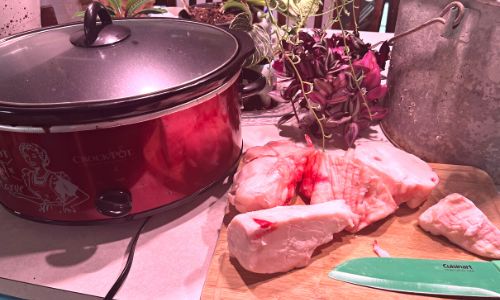
I’m starting off with 3 pounds of leaf fat from my local butcher shop. It cost me $ 4.95 and makes 2 quarts of tallow.
Step 1: We’re going to chop the fat into about inch sized cubes. Since we’re using the dry rendering technique first, which is cooking the fat on its own.
Related: How To Preserve Beef in Glass Jars
We’ll put the fat into the crockpot (or stovetop) on low for six hours stirring every once in a while.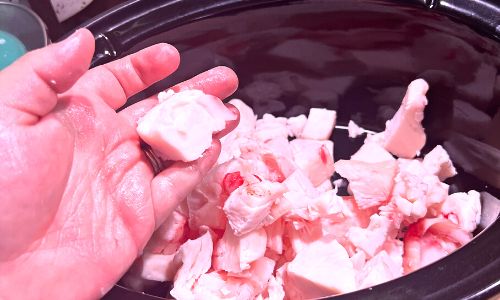
Step 2: Now we’re left with solids and the rendered fat.
You can blend it up and do another dry render for another three hours but the fried fat makes a wonderful little snack called cracklings which my kids can’t get enough of.
⇒ The Long-Lasting Food That Amish Pioneers Turned To In Dark Times
So we’ll strain the fat liquids from the fat solids into a mixing bowl, then feed the crackling to the kids.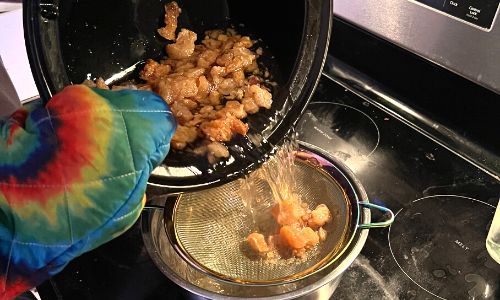
Step 3: We’ll let our first render solidify overnight. Next we’ll pop the tallow cake out of the bowl and scrape off the bottom of any impurities such as granules or discoloration.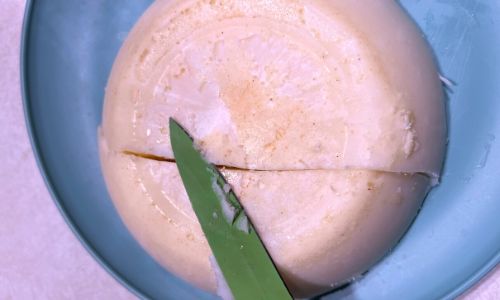
Step 4: Now for the rest of our renders we’ll wet render. Wet rendering is when you add water and salt to draw out as many impurities as we can. The more we render the purer the tallow and the longer it will last.
We’re going to chop the fat up and add it to the pot on the stove top with 2 cups of water and half a cup of table salt.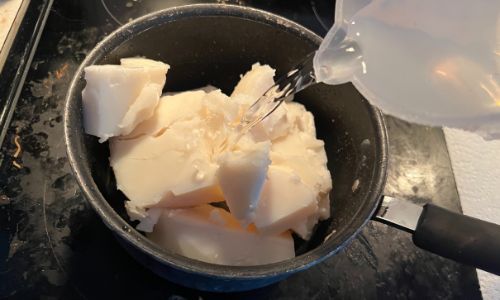
It needs to render on the stove for at least three hours on low heat. Once it’s finished we’re going to pour it into a new clean mixing bowl and stick it back into the fridge to solidify again overnight.
Step 5: Now, just as before, we’ll pull the tallow cake out but this time you can see how the water and fat separated pulling out impurities into the water.
We’re going to give it another scrape and repeat the wet render again for our 3rd render.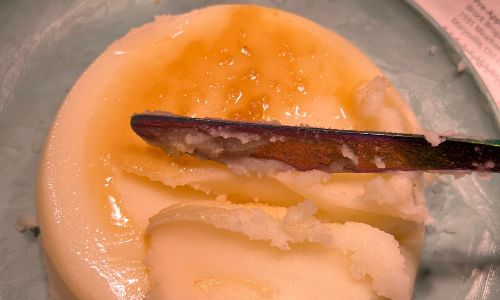
You may have to do more renders depending on how many impurities you get with each render.
This batch is done once I scrape off a few impurities and the water is clear, the tallow is ready to be canned.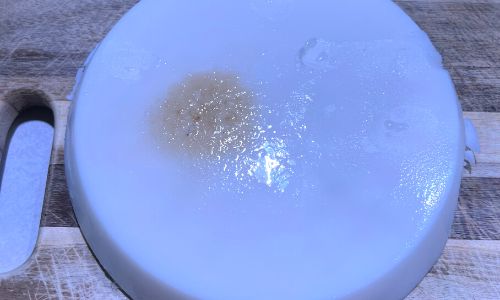
You can reheat it and pour it into the jars but I’m chopping mine up to triple check for impurities and put it into the cans.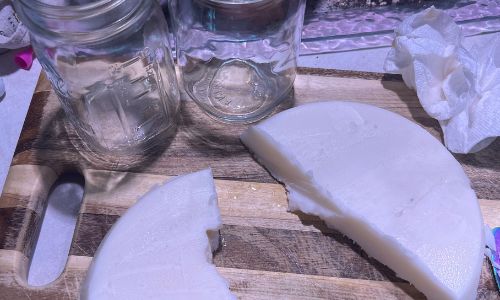
Pressure Canning Tallow
We’re going to use the pressure canning method to preserve our tallow. Pressure canning is the only safe method of preserving low-acid foods.
⇒ 5 Ingenious Ways To Refrigerate Your Food Without Electricity
Low-acid foods include vegetables, meats, fish, and poultry. Pressurized steam creates the needed temperature of 240 degrees Fahrenheit or higher that will destroy the bacteria present in the tallow.
Step 1: Fill your pressure canner with 3 inches of hot water. Unlike the water bath method the jars don’t have to be fully covered. It is imperative to have adequate water level or risk damaging your pressure canner.
Step 2: Put a rack at the bottom of the pressure canner and add your jars. The stew will be hot so I recommend using jar tongs to avoid burning yourself or dropping the jars.
Step 3: Turn on the heat to high on your stove. Pop the lid of the pressure canner and tighten the seal.
Step 4: Once the vent starts steaming, set the timer to 10 minutes.
Step 5: When the venting period is complete, use an oven mitt to place the weighted gauge on the canner.
Step 6: Turn the stove to low heat. Process filled jars in a pressure canner at 10 pounds pressure 25 minutes.
Step 7: Release pressure from the pressure canner. Remove the jars carefully with jar tongs and allow the jars to cool. Check for the seal
Tallow should be on all preppers’ needs list along with a swiss multitool pocket knife and flint. It can do almost anything.
When S.H.T.F. you can’t go to the store and buy soap, but you can make it with beef tallow.
If food supply is low it can be an important source of calories and nutrition. Tallow can light your way when used to make candles. Above all else it makes the best pie crust so no matter the situation you can raise morale.
Making tallow is an easy process that reaps one of the most valuable things you can have in your pantry.

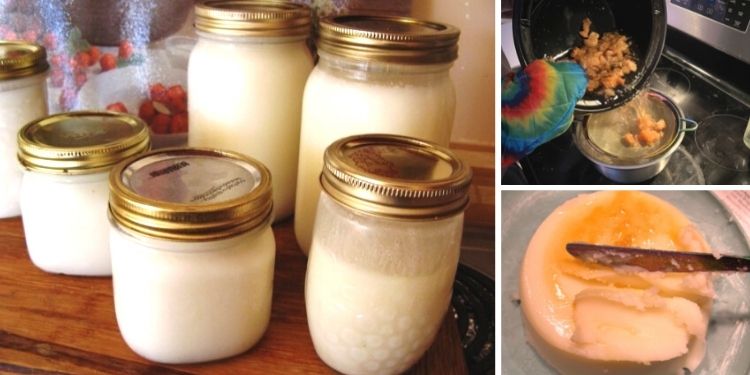













I have no Silver nor Gold, but I do have some tallow. That is how much this will be worth, when the time comes.
Had a great chance to put my wife under some real life survival test.
We were looking at some property to buy, there is an old house there. Well I just can’t help my self, so I looked in the cabinets and found some old food. I thought to my self, so I hallered at her and asked my wife, okay grid down senerio. What would you take from this old food. Well after looking and me, I started grabbing old bags of food that was rotton and some can goods. She blew my mind, she said none of it, it nasty and old. Even asked if it was out of date. lol.
After a minute I looked at her and told her, she was dead.
she asked why.
So I said if you worry about what condition any food is in, other then just rotting or swollen cans and not use what you can find, Then you will DIE…
There will become a time, where if that jar of tallow, is all you have. You will eat that, jar of tallow. if you want to live.
Living is the first part of surviving. The rest is up to YOU…
I done canned several large mason jars of tallow and each and every time I find out the wife had been cooking with it.
Third time she done it, i took my belt to her hide real good. Got her all excited like, to the point where she was waving her keester at me. She done never learn.
Good God, y’all must be an englisher. Last time any man hit a woman in the family he wound up all black and blue laying in the sidewalk naked. It could have been a lot worse. She could have told her mother-in-law who would have wasted good cast iron on him. niio
You’re disgusting
It should be noted that suet is kidney fat, not muscle fat, they have different properties.
If you are making pemmican you must use kidney fat for if you use muscle fat it will have the consistency of a sandwich spread.
Doesn’t “The Lost Ways” book show pemmican being made with muscle fat? On americanpatriotsurvivalist.com website there’s a video showing it being made.with muscle fat. So…which is correct? Kidney fat or muscle fat?
Steven: pemmican is made with dried meat and fruit. Fat is melted ands poured into the bung. We like to hot smoke it which means collecting drippings to use as smoked tallow/lard. niio
Yes, “The Lost Ways,” and literally every other recipe I’ve personally seen for pemmican, calls for tallow, not suet.
I’m planning to make it for the first time, in the near future, so I’ll likely try it both ways; though tallow will come first, since I’ve never even assisted in rendering kidney fat.
I have tried pemmican, made by a hunter friend and his wife, using elk meat and tallow, and it was fairly hard and dry – nowhere near the consistency of sandwich spread.
The tallow I have had experience with in the past was relatively hard at room temperature. Tallow wouldn’t make good drip candles if it weren’t.
I have rendered deer tallow, later used it for bird suit. I melted the fat in the oven, using a large cast iron skillet. (Added benefit – it seasoned the skillet as it melted.) At the time, electricity was not an issue, so I froze the rendered fat until I mixed it with bird seed and peanut butter.
Cloe: Like the old-timers said, if it ain’t deep-fried, is it food? If you want to see your doctor pull out his hair, tell him that, but have a good HDL cholesterol number and low LDL. Mine do. We’re not grain eaters and avoid gluten like it was a Maoist. When I stick to the carnivore diet, I lose pounds. Also, animal fats will not evaporate from the pan like veggie oils, causing asthma attacks. As far as I know, nor do they absorb hydrogen 9a toxin used to make margarine) like veggies fats.
The way I was raised, lard is from pork, all other animals fats are tallow. Chicken is schmaltz but other poultry are called after what they came from. Duck- and goose fat are the best. niio
What does niio mean?
Wonderful Article and the comments were great too
I always save bacon fat, now I’m going to try the tallow
I like tallow better than bacon grease. niio
I don’t know Red, bacon anything is hard to beat…?
WMD: Ture! But bacon is salty. While I live in Arizona, I don’t need a lot of salt. It used to be called smoked lard and cost more than good butter. Mom and Dad had pans under anything they were smoking to catch the drippings. That would be cleaned in boiling water (about 2 inches in a large pot). niio
If you were southern, that bacon fat would be used to fry your eggs, season your dried beans and season turnip greens or other greens.
Wife and I freeze dry a lot of meat, we pour off the fat and juices and render it into tallow. I’ve never heard of using salt – have you tried it without salt to see any difference?
Justin: Mix the broth with enough flour or starch to make dough, then roll out and cook as noodles. Dry them and they cook back fast. We do not add salt to anything and we’re in Arizona and like to be outside working or hiking all the time. Donno why, but we’re very efficient with salt. Genes, I guess. Salted anything, tho, will not store well. Salt absorbs moisture. Even the freezer life of ham and bacon in meat is half of what it is in fresh frozen. If in doubt, use a smoker. The acid is good preservative. niio
Hello trying to learn where to start!!
My wife and I freeze-dry a lot of meat, then drain the fluids and fat to make tallow. Have you tried it without salt to see if it makes a difference? I’ve never heard of using salt.
I don’t have a pressure cooker. Can I can this using my insta pot ?
Instant Pot is a pressure cooker.
Yes, InstaPot is a pressure cooker, but only model to my knowledge reaches high enough pressure to pressure can – I know, because I sought it out, and it was around $150, rather than the $70 or $80 for most InstaPots
Mine will reach 15 psi; which is considered to me the minimum needed to safely pressure can food.
I’d ultimately like to add a stainless steel stove top pressure canner, since we’re on acreage with fairly dense woods, and can cook with wood should the electricity fail.
Depends on your elevation
May I ask what is the longest experienced shelf life of everyone’s tallow?
I have some that is fine so far 6 mos. at room temperature; one jar has been being reused to cook chicken. I only started making it in December. HTH
Any “expired” lard or tallow I have is used to make soap. My soap is pure and if you have any skin issues you should try making some. Without any scent oils! 3 ingredients. Fat, (except butter) water and lye. The tallow I render I mostly use for cooking. I’m canning a batch of tallow today. And am happy to have discovered this site!
I canned tallow for the first time this year. I am excited to try all the things tallow is great for.
What is the shelf life once it has been pressure canned?
I’m using lard I canned in15 and it’s just as good as my 23.